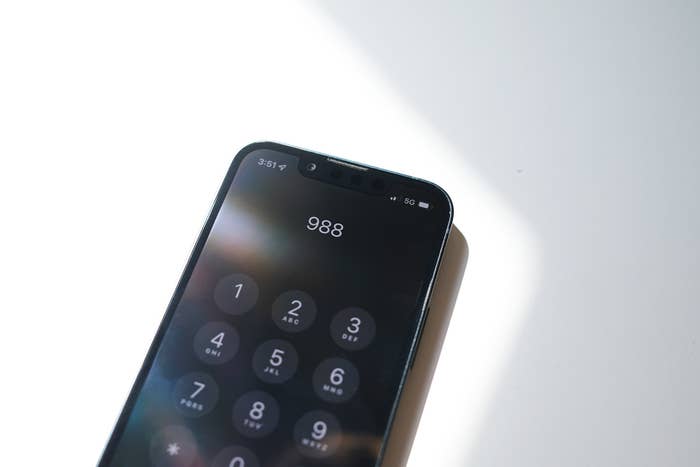
Just like you can dial 911 if you are in danger or physically injured, anyone in the US can now call or text 988 to talk to mental health counselors with the existing National Suicide Prevention Lifeline. (The code is currently available in some parts of the country but should be accessible across the US on July 16.)
The new, easy-to-remember number puts you in touch with free and confidential support 24/7. It’s for anyone experiencing thoughts of suicide, a substance use crisis, or any other kind of emotional distress.
The launch comes nearly two years after the National Suicide Hotline Designation Act was signed into law in 2020, which set the stage for the new code’s activation.
The current Lifeline phone number (1-800-273-8255) is still available for people in need, as well as those concerned about loved ones. You can call that number or contact the Lifeline through an online chat.
The change, experts say, will make lifesaving interventions much more accessible and ensure people get the specific help they need without calling 911, which will free up resources for other types of emergencies.
The availability of the 988 code "is the start of the transition and not an end. There’s still a lot of work to be done to strengthen and transform the crisis care continuum,” Miriam Delphin-Rittmon, assistant secretary for mental health and substance use with the Substance Abuse and Mental Health Services Administration (SAMHSA), said at a press briefing in July.
The transition to the 988 dialing code comes at a time when more people are experiencing mental health crises.
Each year, more people in the US die by suicide than in car crashes.
In 2020 alone, an estimated 12.2 million adults in the US seriously thought about suicide, according to the CDC. Another 3.2 million planned a suicide attempt and 1.2 million tried to kill themselves.
In the same year, suicide was the second leading cause of death for people ages 10 to 14 and 24 to 34, second only to accidents. Certain groups of people have a higher risk of suicide than others, including members of the Indian/Alaska Native communities and white people, as well as people living in rural areas, those working in specific industries like mining and construction, and queer people.
Overall, 45,979 people died by suicide in 2020, which equals about one death every 11 minutes. The suicide prevention lifeline received nearly 2.4 million calls that year.
The good news, however, is that the current mental health crisis in the US can be reversed, experts said, and the new 988 code can help.
A 2018 study of 550 callers who contacted the hotline found that follow-up calls helped prevent 80% of people from killing themselves.
How does the 988 dialing code work?
The National Suicide Prevention Lifeline, which was initiated in 2005, consists of more than 200 local and state-funded crisis centers across the US. When you call or text 988, you’ll be routed to the nearest center based on your area code, which will ensure you’re connected with mental health counselors who are familiar with the resources and services available in your area.
After dialing the code, you’ll hear an automated greeting that will list different options, including a connection to the Veterans Crisis Line (press 1) or services in Spanish (press 2). Otherwise, you’ll be directed to the nearest crisis center where trained counselors will listen, provide support, and connect you to other resources if necessary.
Calls are currently offered in English and Spanish, with translation services available in over 250 languages. Texts and chats are currently only available in English. It also serves teletypewriter, or TTY, users through their preferred relay service or by dialing 711 and then the hotline. The Lifeline is working on adding video phone services for people who are deaf or hard of hearing.
Vibrant Emotional Health, the nonprofit that administers the hotline, says 95% of callers are connected to mental health counselors within 60–90 seconds, and that 34% of calls are about mental health concerns other than suicide.
Police may arrive at your location without your consent
Part of the 988 hotline’s services include “active rescue,” which means staff are required to “take all action necessary to secure the safety of a caller and initiate emergency response with or without the caller’s consent if they are unwilling or unable to take action on their own behalf.”
These actions include accessing the caller’s location to send emergency services, which most of the time involves police. The National Suicide Prevention Lifeline says less than 2% of calls involve emergency services, over half of which occur with a caller’s consent.
Although involuntary interventions are intended to be a last resort, some mental health advocates say its use may cause unintended yet harmful consequences. This is particularly true for members of marginalized communities who already face high risks of being criminalized, harmed, or harassed by law enforcement who aren’t properly trained in responding to mental health crises, according to Yana Calou, the director of advocacy for Trans Lifeline, a nonprofit and hotline offering emotional and financial support to trans people.
“People don’t know that police might arrive at their school or job,” Calou told BuzzFeed News. “And for people who aren’t insured, having an ambulance arrive that you didn’t call yourself can really add to financial stress, which is one of the top suicide indicators.”
What’s more, there may be medical bills from emergency room visits, psychiatric holds, medications, and counseling, all of which are required by the court in involuntary hospitalizations.
“It’s something we’re really worried about with 988,” Calou said, adding that these interventions can actually prevent people from calling for help in the first place.
There are also some privacy concerns for callers who may be undocumented and engaging in sex work, for example, who may end up being criminalized as a result of seeking mental health support.
Calou said Trans Lifeline does not engage in nonconsensual interventions “because we want people to feel like they can be really honest about experiencing suicidality, which is a pretty normal experience.”
“Depending on the area that you live in, you might get a really different response when services are dispatched to you,” Calou said. “People need to make those decisions for themselves about whether they need that in-person support. But also we need to educate people and give them informed consent about what those services might entail.”
Overall, it’s important that mental health services and the staff that run them reflect the communities they serve and are trained to respond to their specific needs, said Preston Mitchum, director of advocacy and government affairs at the Trevor Project, a nonprofit and hotline focusing on suicide prevention for young LGBTQ lives.
“Mental health challenges are not one-size-fits-all, and neither are the solutions,” Mitchum told BuzzFeed News in an email.
What happens after people start using the 988 hotline?
All calls to the 988 hotline are routed to general mental health counselors within the Lifeline network, but organizations like Trans Lifeline and the Trevor Project are trying to change that.
Both Calou and Mitchum told us that they hope their services can one day be included in the 988 network and have calls redirected to their own trained counselors so that members of specific communities get the support that best suits them.
Mitchum also added that the Trevor Project is urging Congress to immediately pass the bipartisan 988 Implementation Act, which would provide states with federal funding to support their community-based crisis responses. That would include additional staff to meet the surge in demand following 988’s activation. The act would ensure that 988 serves all communities equally.
Research posted in June by the National Academy for State Health Policy found that only 21 states have enacted legislation to implement and fund the rollout of 988.
The Biden administration invested $432 million into the 988 transition, which has led to a significant boost in the Lifeline’s call capacity, according to Delphin-Rittmon. From February to May this year, the Lifeline has been able to answer 27,000 more calls because of the extra funds.
Over time, government officials say they envision 988 offering additional services like mobile crisis teams or stabilization centers, which provide voluntary support and treatment to anyone in a crisis due to mental health or substance use. However, to get there, more funding is critical.
“988 really offers an opportunity to expose gaps and weaknesses in our system, and frankly that gives us an opportunity to target investments because the reality is we have had a dysfunctional crisis response system in this country for decades,” Angela Kimball, senior vice president for advocacy and policy at Inseparable, a group that fights for the future of mental health policy, said during the press briefing.
The fact is, Kimball said, that the rollout of 988 isn’t going to be perfect, but instead of looking at it as a failure, we should see it as an opportunity to consider how we can integrate crisis responses into the healthcare system, “not as a grant-funded extra.”
“A lot of the harm that people experience from calling these hotlines doesn’t happen in the hotlines themselves, but rather with the emergency response infrastructure we have in this country, like emergency rooms, police, and jails, which are really inadequate,” Calou said. “How do we build infrastructure that doesn't rely on those systems so we can live in a world where we trust that the help we seek during a crisis will actually be supportive.”
The US National Suicide Prevention Lifeline is 1-800-273-8255. The Trevor Project, which provides help and suicide-prevention resources for LGBTQ youth, is 1-866-488-7386. Find other international suicide helplines at Befrienders Worldwide (befrienders.org).
